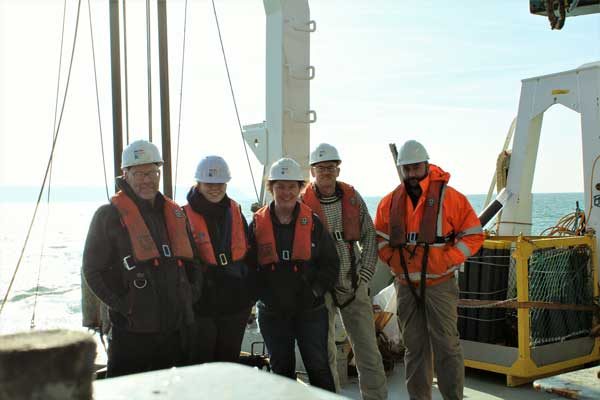IT Sligo has joined the University of Bradford’s “Europe’s Lost Frontiers” research team, which set out to explore the Irish Sea this week.
Along with University College Cork and the Irish Marine Institute, the group will carry out an expedition to explore the extensive submerged landscapes that exist between Ireland and Great Britain.
Following the last Ice Age, large areas of habitable land were submerged following climate change and sea level rise across the world.
Globally, the sea level rose around 120 metres and an area more than twice that of the modern United States of America was lost to the sea.
Beneath the waves of the Irish Sea is a prehistoric ‘palaeolandscape’ of plains, hills, marshlands and river valleys in which evidence of human activity is expected to be preserved.

Scientific crew of the RV Celtic Voyager L-R: Dr Martin Bates, Rosie Everett, Eithne Davis, Dr C. Richard Bates, Kevin Kearney.
This landscape is similar to Doggerland, an area of the southern North Sea and currently the best-known example of a palaeolandscape in Europe. Doggerland has been extensively researched by Professor Vince Gaffney, Principal Investigator of the “Europe’s Lost Frontiers” Project.
Professor Vince Gaffney said:
“Research by the project team has also provided accurate maps for the submerged lands that lie between Ireland and Britain and these are suspected to hold crucial information regarding the first settlers of Ireland and adjacent lands along the Atlantic corridor.”
To provide this evidence, sediment is currently being taken from 20 sites by the Irish Research Vessel RV Celtic Voyager in Liverpool and Cardigan Bays.
This research started on Wednesday (February 21) and will continue until Sunday (February 25) and the findings will be studied by an international research team.
Dr James Bonsall, from the Centre for Environmental Research Innovation and Sustainability (CERIS) in the Dept. of Environmental Science at IT Sligo, is the Chief Scientist for this phase of the research. His CERIS colleague, Environmental Scientist Eithne Davis will be on board the RV Celtic Voyager, directing operations.
Dr James Bonsall said:
“It is very exciting as we’re using cutting-edge technology to retrieve the first evidence for life within landscapes that were inundated by rising sea levels thousands of years ago. This is the first time that this range of techniques has been employed on submerged landscapes under the Irish Sea.
“Today we perceive the Irish Sea as a large body of water, a sea that separates us from Britain and mainland Europe, a sea that gives us an identity as a proud island nation. But 18,000 years ago, Ireland, Britain and Europe were part of a single landmass that gradually flooded over thousands of years, forming the islands that we know today.
“We’re going to find out where, when, why and how people lived on a landscape that today is located beneath the waves”.
Key outcomes of the research will be to reconstruct and simulate the palaeoenvironments of the Irish Sea, using ancient DNA, analysed in the laboratories at the University of Warwick, and palaeoenvironmental data extracted from the sediment cores.
The studies will be of immense value in understanding ‘first’ or ‘early’ contact and settlement around the coasts of Ireland and Britain, but also the lifestyles of those people who lived within the inundated, prehistoric landscapes that lie between our islands and which have never been adequately explored by archaeologists.
“Now we will be able to reconstruct through sedaDNA both sides of the story of the rising tides in the Mesolithic around the UK and gain a more complete insight into those early stages of Neolithisation during which Britain became an island nation.”
Professor Robin Allaby (University of Warwick)
“The incoming data will allow us at the NVIDIA Joint-Lab on Mixed Reality, University of Nottingham Ningbo China to develop strategies for complex systems modelling for the ‘Lost Frontiers’ project. The unprecedented volume and resolution of the data we gather initially will give us a foundation from which to develop simulation strategies for finding settlement trends within the submerged landscapes thousands of years ago, with an ultimate goal of discovering the mechanisms which contributed to the transition between hunter-gatherer and past agricultural societies.”
Professor Eugene Ch’ng (University of Nottingham/Ningbo)
“This is a very exciting opportunity as the cores we are collecting are the first drilled in the Cardigan Bay sea bed since perhaps the 1970’s. They are going to provide us with material that will really help us to understand how Cardigan Bay changed as the sea flooded across the landscape during the time that people were coming back to Wales after the last glaciation.”
Dr Martin Bates (University of Wales, Trinity St Davids)